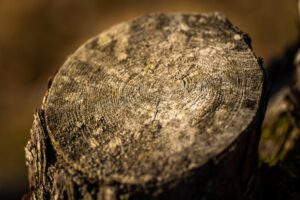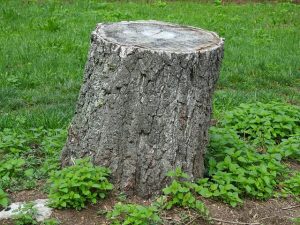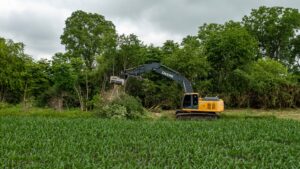Stump Removal Near Me

Stump Removal Near Me
How to get rid of tree stumps is one of the most frequently asked question in the industry. Once you have had a tree removed you are left with a typically unsightly reminder, the stump. Tree stumps are an eyesore, a tripping hazard, and they can attract unwanted pests like termites or even fungi and bacteria. If left to simply decay and rot away on its own, without any sort of treatment, a stump can take up to ten years to disappear. When it comes to rotting a tree stump in Utah, the rate of decay depends on many different factors such as species of tree, size of the tree, and the climate and weather conditions.
As your leading Utah arborist, we do stump grinding in the Utah and surrounding area, although due to the demand we do have to limit our grinding services and can only offer it to current tree service clients and not as a standalone service.
To remove a tree stump you can try to tackle the job yourself, although stump grinders are quite heavy and can be difficult to use at times. So how do you get rid of a tree stump then? What is the best way? Well, the answer is in the original suggestion of letting it rot away, but doing so quickly.
How To Get Rid Of A Tree Stump Fast?
The fastest way to remove a tree stump, with and without using a grinder, is the chemical method. By applying chemicals to holes drilled into the stump, you speed up the natural decay process and the remaining tree fibers and roots will break down much more quickly. It is considered one of the best ways to remove a tree stump from your yard. Here is how to use this method by following these steps.
DIY Steps To Rotting A Tree Stump From A Leading Arborist:
Begin on a dry day or after a number of dry days if possible. This way the tree stump will be looking for liquid and nutrients and will soak up the chemicals faster.
If you are capable, use a chainsaw to cut the remaining part of the tree as close to the ground as possible. By doing this the chemicals will have less material to eat through. Chainsaws can be dangerous though, so make sure you always use caution, wear steel-toed boots and eye protection.
Once the tree stump is as close to the ground as you can comfortably get it to go, drill a number of holes into the top of the stump and along the sides in a downward direction. The bigger the drill bit the better, and each of the holes should be a few inches deep.
After drilling the holes into the stump in different places, you will apply the chemicals that will break down the remaining wood. Utah does have strict legal restrictions about the kind of chemicals you can purchase for this sort of project. Ideally, you would want a commercial fertilizer that is high in nitrogen, since it will give you the fastest results, but cow manure is also effective. Another more natural alternative is Epsom salt. It is also a cost-effective solution as a 19lbs page starts at $10. It has similar dissolving properties to nitrogen but is a more organic approach. When you have chosen the chemical you will use, pack the holes with as much of it as you can.
Then soak the ground around the stump and wet the top and sides of the stump. After the stump is wet, cover it with a plastic tarp to trap the moisture around the stump. Moisture is ultimately what will help the chemicals break down the wood particles faster.
The next step is to apply mulch over the top of the plastic tarp. Organic mulch, like hay or tree bark, is best for this task as it will retain more moisture and help to keep the tarp in place.
You can use rocks and stones to weigh down the tarp further to help keep it in place, although this step is considered optional.
Once you have completed all of these steps, you are officially rotting a tree stump. This process is a speeding up of nature, and we all know that nature can take its time, so you should expect that it will take some time to work. How can you speed up the stump rot process even more? You can repeat the rotting steps periodically if you notice the mulch has grown dry.
How Much Does It Cost To Remove A Stump?
The overall cost for a stump removal is largely dependent on the method you choose to use. If you chose to do it yourself, it would be the cost of materials needed. Whereas, if you live in the nearby Utah area, with easy access to the stump, the average cost is about $6 per inch in diameter with $150-$200 minimum charge.
Looking To Remove a Tree Stump Quickly?
Ultimately, the quickest way to remove your tree stump and return your yard to a flat surface is the method of stump grinding. Although our grinding services are limited, if you are in need of a tree removal service in the Utah, area, or if you are looking to get some stumps removed don’t hesitate to contact the tree experts.
If you’re not a current or past tree client and have a stump you’d like removed, read more about stump rot and how to safely remove the tree stump yourself.
When your stump is ground, you can expect that there will be no masses of the stump left underground. The stump grindings, which are the wood shavings from the stump mixed with dirt, are left behind. You can use these grindings as mulch around your yard. Please remove the grindings prior to replanting any plants or trees in that area.
Stump Grinding FAQs
What is the average cost for stump grinding?
If you live in the nearby Utah Metro area with easy access to the stump, stump grinding cost averages about $6 per inch in diameter with a $150-$200 minimum. Anything that makes the stump harder to access and remove such as a fence or retaining wall or anything breakable such as a flagstone patio would increase the price from there. Also removing the stump grindings is almost always an additional charge.
Is It better to grind a stump or remove it?
There are many ways how to get rid of tree stumps, and there are advantages and disadvantages for either removing a stump or grinding it. For removing a stump the advantage is there is no stump grinding left behind. The disadvantages are that removing all but the smallest stumps usually requires large equipment such as a loader or excavator. In addition, it is usually pretty hard to find a place to dispose of them. For grinding a stump the advantages are that it can be done to almost any stump in any location or a reasonable fee and the disadvantages are that the grinding as usually left behind for the property owner to deal with.
Can you grind down a tree stump with a chainsaw?
There are stump grinders that attach to a chainsaws powerhead, but grinding a stump with a regular chainsaw would be exceptionally difficult as the chain would dull every time it hit even a small amount of dirt. It also sounds very dangerous.
Can I use ground up tree stump as mulch?
Yes, a ground-up tree stump makes an excellent mulch product.
How much does it cost to rent a stump grinder from Home Depot?
In the Utah Metro area $299 per day and $209 for 4 hours as of 3/20/19 to rent a grinder for stump removal in Utah, OR.
Does stump grinding kill roots?
No, in fact, the roots are sometimes spurred to grow more from the shock of having the tree removed and stump ground out.
Does tree removal include the stump?
The answer is almost always no. The removal of the stump in the ground is for an additional fee. Tree removal bids are very specific so any extra services such as stump grinding, wood removal, or tree removal permits are not included unless expressly stated.
Will tree stumps attract termites?
Yes, but not all termites will damage your home. It will take an exterminator to determine which kind you have should your stump become infested.
Can a tree grow back from a stump?
Depending on the type of tree they can grow back but this would not be a tree that you would want to keep as its structure would be compromised and thus it would be likely to fail and damage your property.
Contact the tree experts about stump removal in Utah
If you live in the Utah area and are looking to have a tree removed and are also interested in stump removal and grinding contact our nearby team of Utah stump grinding service professionals.
About Saratoga Springs, Utah
Saratoga Springs is a city in Utah County, Utah, United States. The elevation is 4,505 feet. It is part of the Provo–Orem, Utah Metropolitan Statistical Area. The city is a relatively new development along the northwestern shores of Utah Lake. It was incorporated on December 31, 1997 and has been growing rapidly since then. The population was 37,696 at the 2020 Census. Saratoga Springs became a city in 2001.
Neighborhoods in Saratoga Springs, Utah
Harvest Hills, North Shore Neighborhood Park, Saratoga Springs, Silver Lake, Western Hills by Bach Homes, stillwater, Neighborhood Library, Jacobs Ranch Park, Clinton, Eagle Park, Regal Park, Saratoga Hot Springs, Northshore, Island Park, Wayman Park, Neptune Park, Shoreline Park, Inlet Park, Patriot Park, Wildflower at Saratoga Springs
Things To Do in Saratoga Springs, Utah
Bus Stops in Saratoga Springs, Utah to Truco Services, Inc.
Bus Stop in Redwood Rd @ 1418 N Saratoga Springs, Utah to Truco Services, Inc.
Bus Stop in Alpine School District Transportation West Office Saratoga Springs, Utah to Truco Services, Inc.
Bus Stop in Harvest Hills Blvd @ 224 Saratoga Springs, Utah to Truco Services, Inc.
Bus Stop in Pony Express Pky @ 3916 E Saratoga Springs, Utah to Truco Services, Inc.
Bus Stop in Sparrowhawk Way @ 7746 N Saratoga Springs, Utah to Truco Services, Inc.
Bus Stop in State St @ 687 E Saratoga Springs, Utah to Truco Services, Inc.
Bus Stop in State St @ 1870 N Saratoga Springs, Utah to Truco Services, Inc.
Bus Stop in State St @ 553 W Saratoga Springs, Utah to Truco Services, Inc.
Bus Stop in Harvest Hills Blvd @ 478 W Saratoga Springs, Utah to Truco Services, Inc.
Bus Stop in State St @ 632 E Saratoga Springs, Utah to Truco Services, Inc.
Bus Stop in Pony Express Pky @ 3917 E Saratoga Springs, Utah to Truco Services, Inc.
Bus Stop in State St @ 800 W Saratoga Springs, Utah to Truco Services, Inc.
Driving Directions in Saratoga Springs, Utah to Truco Services, Inc.
Driving Directions from Dave E Tree to 4640 Commerce Dr, Murray, UT 84107, USA
Driving Directions from Utah Tree Works - SavATree to 4640 Commerce Dr, Murray, UT 84107, USA
Driving Directions from A Plus Affordable Tree Service to 4640 Commerce Dr, Murray, UT 84107, USA
Driving Directions from DSI Tree Service to 4640 Commerce Dr, Murray, UT 84107, USA
Driving Directions from Family Tree Services LLC to 4640 Commerce Dr, Murray, UT 84107, USA
Driving Directions from Cascade Tree Services to 4640 Commerce Dr, Murray, UT 84107, USA
Driving Directions from Tree-Rex Tree Service, LLC to 4640 Commerce Dr, Murray, UT 84107, USA
Driving Directions from Davis Trees to 4640 Commerce Dr, Murray, UT 84107, USA
Driving Directions from Atlas Tree Service to 4640 Commerce Dr, Murray, UT 84107, USA
Driving Directions from Peterson Tree Care to 4640 Commerce Dr, Murray, UT 84107, USA
Reviews for Truco Services, Inc. Saratoga Springs, Utah
Marissa Burton
TruCo is a great company to work with for your commercial landscaping and snow removal needs! Rob is excellent to work with. He is very timely in providing quotes and has a lot of great feedback and suggestions to provide on what will look great, fit within your budget, and is knowledgeable on plants that will thrive with Utah's ever changing weather conditions. I have been impressed with TruCo's landscape maintenance as well as landscape projects which have had a quick turnaround time. I would highly recommend using TruCo!
Yvonne Olson
I experienced excellent all around service from landscape improvement design, scheduling and professional installation completed within the timeline we discussed. Rob, the manager does an excellent job of communicating, overseeing the install crew and making sure his customers are 100% satisfied with the job. Highly recommend TruCo for all landscaping needs.
Heather Whiting
We hired TruCo to do a new install of sprinklers, sod, spigot, and bury downspouts. We even have a wifi transmitter for our control box we can access from an app on our phones! We absolutely love the professionalism and quality of their work!! Our sales rep Pete was the best to work with, we highly recommend him to anyone in the market for landscaping. It was awesome seeing the finished results and we're incredibly excited to enjoy our new space!
Jan Merideth
TruCo installed all of our plants, trees and shrubs, drip lines, and boulders. Then they installed our amazing beautiful firepit. We loved the results and they guarantee all plants and trees up to a year. They were great and easy to work with. They listened to our needs and wants and met them 100%. Our HOA sent us a letter telling us they appreciate all the work and the way our yard looks and let us know we added value to the property. Win/Win
Michael Sorensen
Avoid working for this company. They will promise you things to get you in, then tell you there is no documentation about said things. Extremely unprofessional. Update to response - please dont try to justify. PTO was promised by the hiring manager on day 1 due to the conditions. Your company refusing to honor the agreement and tell me that there is no documentation is the problem. I quit after being told that you would not honor the PTO, not before.


